2018.03.13 Tuesday Stretch
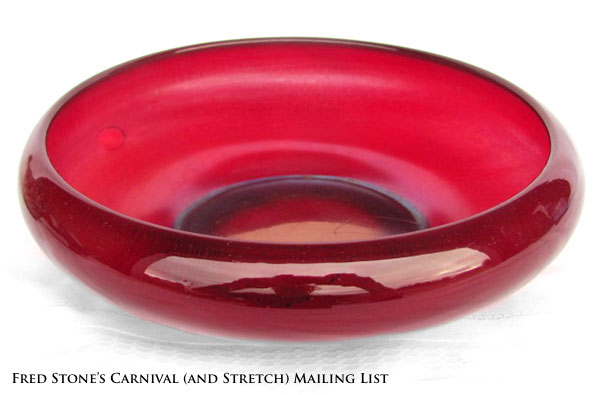
Cal here from the stretch glass team. There have been some very spectacular sales of carnival glass pitchers over the past year, so I thought tonight I would begin a discussion of stretch glass pitchers, tumblers and goblets produced during the early stretch period; additional ones were made during the late stretch period. Fortunately, or unfortunately, I am not aware of any stretch glass pitcher selling for a price approaching the amounts recently paid for the rare carnival glass pitchers. Nevertheless, there are some pitchers and tumblers which command higher prices than do others and I thought you might like to be aware of which ones are common and which ones are not so common. The one stretch glass pitcher & tumbler sale which does stand out took place a number of years ago and included a Ruby Ice Chesterfield pitcher and 6 tumblers. I don’t recall if the pitcher had a cover or not. The hammer price was reportedly $25,000. I am not aware of another stretch pitcher and tumbler set approaching that price.
Several of the early period stretch glass companies made pitchers and tumblers; only a couple offered goblets. This makes stretch glass goblets much harder to find than most of our pitchers and tumblers. I see carnival glass wine goblets frequently; we do not have any wine goblets in stretch glass, but we do have larger goblets, most likely for iced tea, and a bridge goblet (aka a footed tumbler).
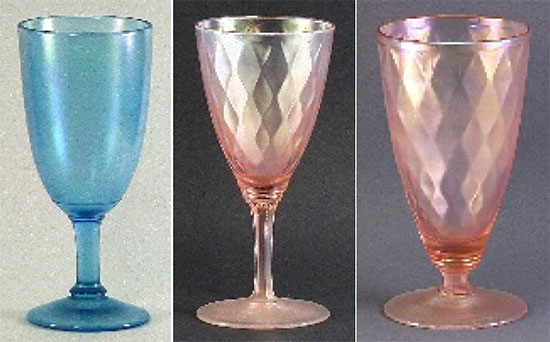
The pitchers and tumblers were sold together in sets and were intended to be used for juice (grape juice, in particular, in at least one case), lemonade or iced tea. There are two basic shapes of pitchers: tankards and bulbous. There are several shapes of tumblers.
Fenton had at least four tankard-style and two bulbous pitchers. I say “at least” because there is one pitcher which may be made by Fenton or Diamond. We are still researching this. I’ll talk about that one another night. They also made numerous styles – and sizes – of tumblers. Certain tumblers ‘go with’ certain pitchers. And, Fenton offered a selection of coasters and bases for their pitchers and tumblers. Tonight we are going to look at both the tankard and bulbous pitchers Fenton produced in several colors and treatments.
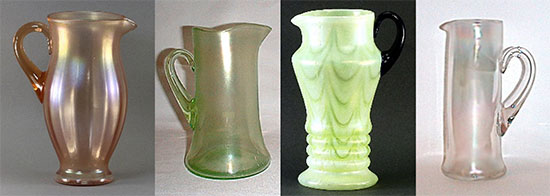
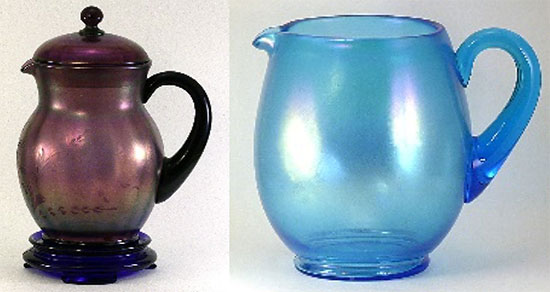
None of the tankards had covers but one of the bulbous pitchers should always have a cover and the other one never has a cover. In other words, sometimes it is ok for the bulbous pitcher to be topless and other times it is it is not. All Fenton early period stretch glass pitchers have applied handles, none were molded. The same is true for the tumblers if they have a handle (many do not). This is one easy ‘rule’ to keep in mind when trying to ID or date a stretch glass pitcher. The color of the handle varies and can be Cobalt Blue, Celeste Blue, Pink, Topaz or Crystal. Typically, the handle color matches the color of the pitcher unless the handle is Cobalt or Crystal, in which case the handle is generally going to be in contrast to the color of the pitcher (the grape juice pitcher is the exception; here the crystal handle is applied to a Persian Pearl pitcher). The handles are not iridized – this is another easy ‘rule’ to keep in mind. While we find Cobalt handles on Celeste Blue, Topaz, Marigold, Wistaria, Curtain Optic and Rib Optic pitchers, we only find pink handles on the Velva Rose pitchers and we do not see the pink handles on any other pitchers.
Here is another easy ‘rule’ to remember when it comes to pitchers and handles: Velva Rose pitchers have pink handles and pink handles are only on Velva Rose pitchers. If you find an exception to this, you have made a new discovery in stretch glass! BTW, this is where the “easy” stops when it comes to remembering what’s what with pitchers and handles.
Let’s take a look at the four different tankard-style pitchers Fenton made. First is what I would consider the most common style.
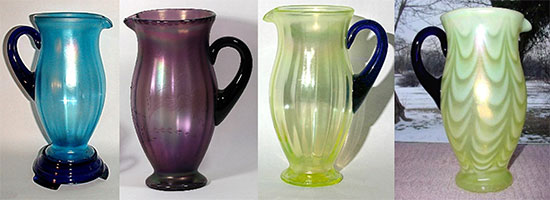
It is #222 and can be described as “a bulging tankard” because it is narrow at the base, gets wider in the middle and then is somewhat smaller at the top. Sometimes these are referred to as the “hour-glass” shape. Whatever we call it, most of you have seen these and many of you probably own one or more in the color(s) mentioned earlier. They are common in Topaz and Celeste Blue. Harder to find are the Wistaria and Velva Rose (shown earlier) examples. I am not aware of this pitcher being known in any of the other Fenton colors. It is noteworthy that they are not known in Florentine Green because there are other Fenton pitchers in that color, which Fenton used widely during the early stretch glass period. These pitchers are also not known in Persian Pearl or Tangerine even though guest set pitchers and matching tumblers were made in these colors. Again, if you find this pitcher in one of these colors, you have a rarity in your hands.
Sometimes the #222 pitchers are decorated with wheel cut designs, usually of flowers (as pictured above). It is possible that they exist with other cuttings. If you have one, we would love to see it. And sometimes the #222 pitchers include the “Curtain Optic” treatment (also pictured above). I am not aware of a #222 pitcher in “Rib Optic” which was used in other style pitchers. You will note that the Celeste Blue pitcher is sitting on a base. This is not a black base, although is it very similar to one; it is a cobalt blue base. These bases were made for the #222 pitchers and match the cobalt blue handles. These bases are scarce. There are many more pitchers than bases and the bases are coveted by stretch glass collectors.
The next style of pitcher is a straight-sided tankard. This was only made in a small size grape juice pitcher which measures 2 3/4” wide at the top, 8 1/4” tall and 3 1/2” wide at the base. These are known in Florentine Green and Persian Pearl. There may be one in Celeste Blue, also.
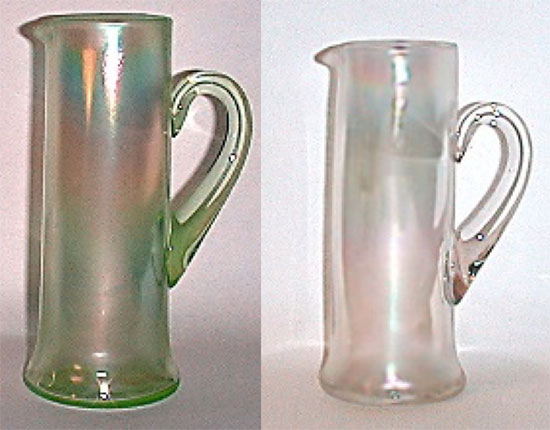
I have not seen a stretch glass one with a wheel cutting but I have a crystal one with wheel cuttings of grapes on it.
The third tankard-style pitcher is similar to the grape juice pitcher, but larger and with a wavy top edge. Where the grape juice pitcher is basically flat around the top edge other than for a pouring spout, the larger straight-sided pitcher has an accentuated pouring spout and an uneven top rim. It is also more flared out at the base than is the case with the grape juice pitcher. It is known to me in Celeste Blue and Florentine Green; it may exist in other colors.
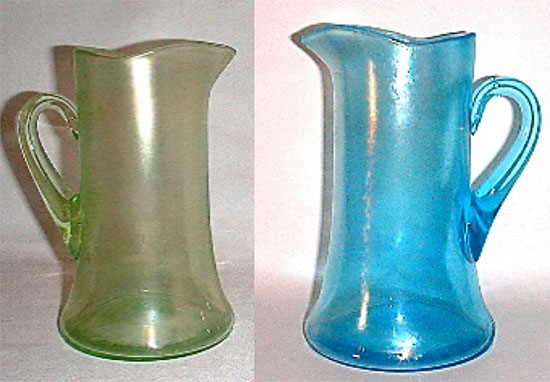
The final tankard-style shape is referred to as the “Ringed” pitcher because it has rings of glass in the lower section of the pitcher. These rings were in the mold into which the pitcher was blown. This pitcher is known in 3 sizes with the smallest size seemingly appropriate for juice. The heights are 10 1/4”, 9 1/4” and 8 1/4”.
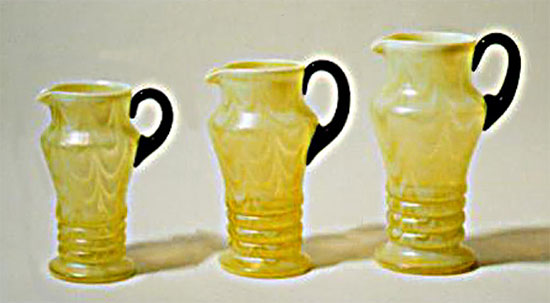
The Ringed pitchers are usually found in “Curtain Optic” or “Rib Optic” but they also exist in shiny Marigold, looking much like carnival glass. The Marigold ones often have wheel cut designs on them while the Curtain Optic and Rib Optic ones do not. Most of the Ringed pitchers are found in Topaz.At least one of the Curtain Optic pitchers is known in Persian Pearl and it is a beautiful pitcher. Here is a ring optic pitcher in Marigold with one of the cuttings. We believe the cutting was done at Fenton.
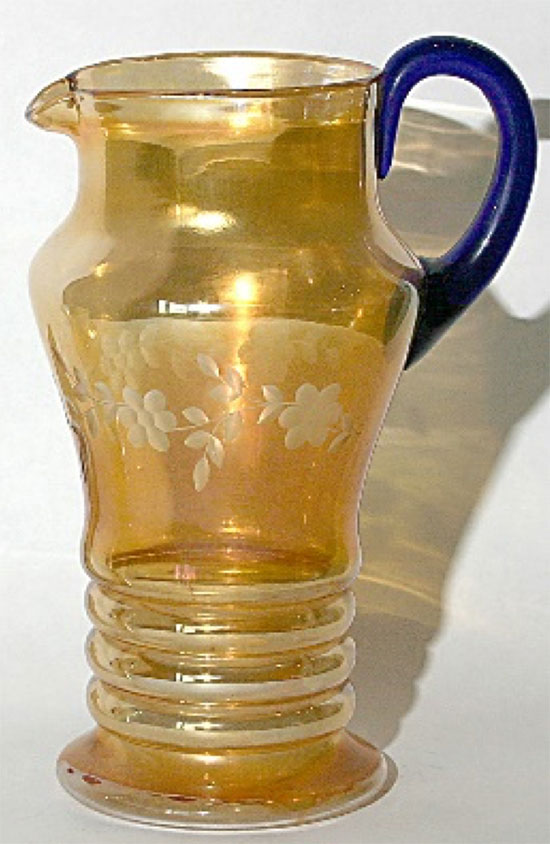
Let’s look at the two bulbous pitchers Fenton made.
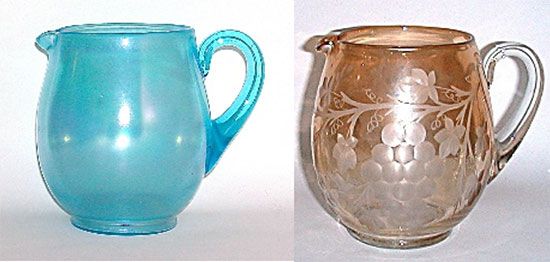
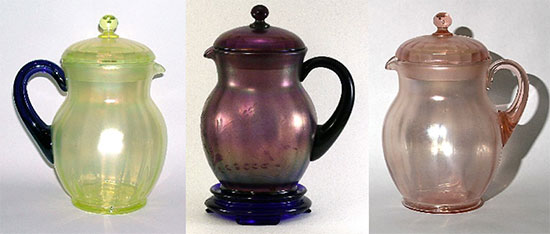
One is quite simple, basically a plain bulbous pitcher. It was NOT made with a cover, however, sometimes these pitchers acquire a cover, usually that cover belongs to a Diamond pitcher of similar size. The other bulbous pitcher by Fenton is somewhat more involved and has a rib optic design; it is known as #220. The #220 should always have a cover, although they are sold ‘topless’ in auctions and elsewhere. The cover fits down inside the top of the pitcher and has an attached knob finial. The pitcher and cover are found in Topaz and Celeste Blue (common), Wistaria (hard to find) and Velva Rose (rare). There were at least 2 different cuttings used on them. One is a large flower and the other is a band of flowers.
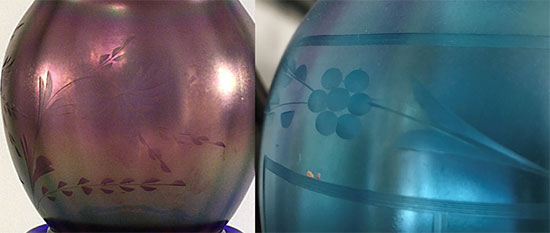
Many of these have no cutting on them. The Celeste Blue #220 pitcher is also known with a crystal handle (hard to find) in addition to the usual Cobalt blue handle.
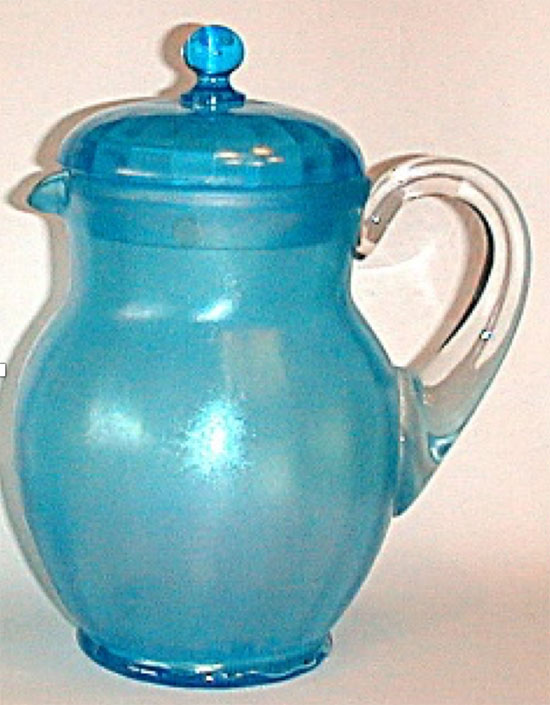
One final note, the finial on the cover could be celeste blue, topaz, wisteria, pink, cobalt blue or crystal. I do not believe we have been able to determine if there was a ‘standard’ for these at Fenton. One might conjecture that the knob should match the handle, but that doesn’t always seem to be the case. Of course, we have no way of knowing if covers have been switched over the years. This may remain one of the great mysteries. Again, the knob on the Velva Rose pitcher is always pink! (well, at least for the very few pitchers that are known at this time).
Ok, we are going to stop here for now. In three weeks when I am back for my next Tuesday Stretch, we will continue discussing more Fenton offerings. After that we will look at the pitchers, tumblers and a goblet produced by Diamond. And three weeks after that, we will look at the contributions by Imperial and after that will be the items from Northwood. Once we finish all the early period items, I’ll get into the late period pitchers, tumblers and goblets. In between, feel free to ask questions, offer comments, share photos of your stretch glass pitchers, tumblers and goblets, etc.
Have a great couple of weeks and please consider joining us on April 12 for our next Stretch Out Discussion call focusing on Fenton late period stretch glass made for QVC. This will be very interesting and will help us identify some of the stretch glass we are beginning to see for sale in shops and malls. All the details for joining the discussion are on www.stretchglasssociety.org. We look forward to your participation.
